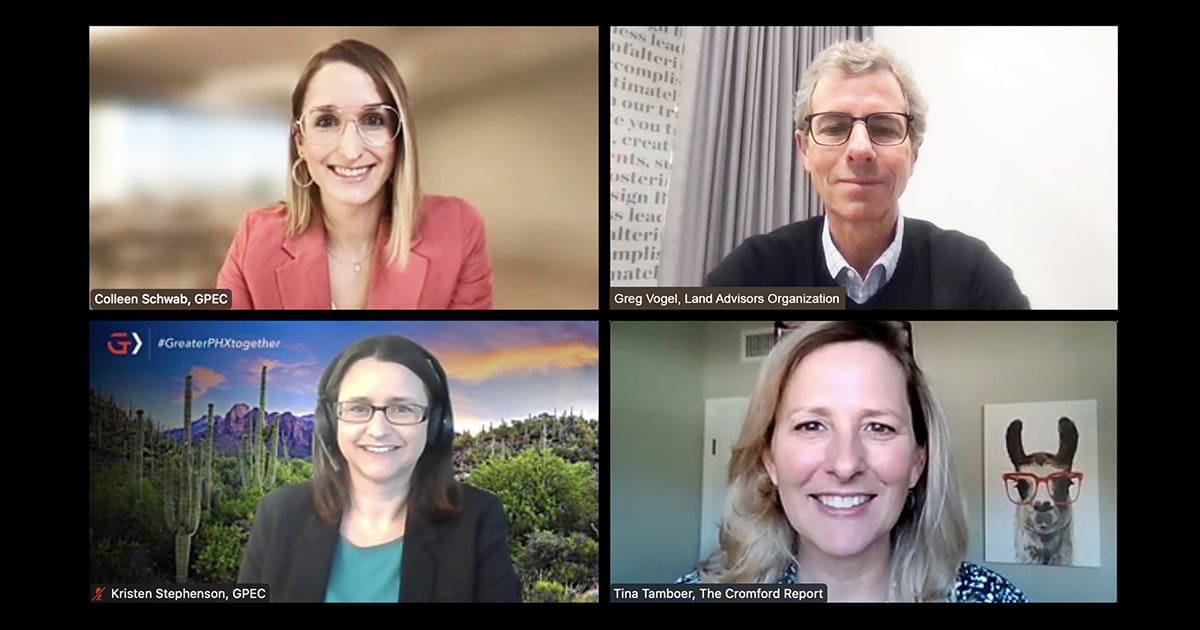

Regional Report: Economic Trends
Published: 02/01/2022
Regional experts provide Greater Phoenix housing, economic forecast for 2022
With job loss from the COVID-19 pandemic fully recovered in Arizona and unemployment rates near an all-time low, a group of local experts discussed Greater Phoenix housing and land availability, key market strengths and the regional economy as it continues its upward trend early in 2022 during the latest Greater Phoenix Economic Council Regional Report.
Regional Report speakers:
- Kristen Stephenson, Senior Vice President of Research & Analytics, Greater Phoenix Economic Council
- Tina Tamboer, Senior Real Estate Analyst, The Cromford Report
- Greg Vogel, CEO, Land Advisors Organization
- Moderator: Colleen Schwab, Chief Performance Officer, Greater Phoenix Economic Council
“A lot of the strategic investments the state and region made over the last decade or so has played out very well to put us in this position where our economy is pretty well-balanced among industries, and frankly I think this allowed us to recover from the recession faster than most other economies,” Stephenson said. “Arizona has fully recovered its jobs, about the third-fastest recovery amongst all states, so we're in a very good position going forward.”
Economic Overview
Not only has Greater Phoenix recovered all jobs lost since April 2020 – overall employment is 23% higher than it was in February 2020.
There have been upticks in several industries, the most pronounced being transportation and utilities. This sector not only gained back the 3,300 jobs it lost between February and April 2020, it added an additional 28,500. Some industries continue to work toward pre-pandemic employment numbers, such as leisure and hospitality, which has recovered 82% of jobs.
Manufacturing growth is outpacing construction growth, which Stephenson pointed to as an indicator of an evolving market.
“It’s a very interesting place for our market to be,” Stephenson said. “We still do have a strong construction sector to support the building of developments that are coming in here, but having that base industry grow as well is a very positive sign for our economy going forward.”
The unemployment rate is down to 2.4%.
“Essentially everybody that wants a job has one. What you're seeing in the unemployment is just generally kind of natural churn of the market,” Stephenson said.
The cost of living continues to increase at a slightly higher rate than the 7% national inflation level. Arizona has become more expensive than competitor markets Dallas and Salt Lake City, but costs remain well under pricier western markets Los Angeles, San Francisco and Seattle.
Greater Phoenix housing market
Tamboer pointed to the supply of houses against the demand of the population and migration patterns as an indicator that housing prices will continue to rise steadily. It is normal for Greater Phoenix to start January with between 16,000 to 21,000 active listings in the MLS. This year, the region began with about 5,200 active listings.
About 45% of houses are selling at over asking price – three times the average rate seen between 2015-19 – as buyers continue to pay for the short lifespan of homes on the market, averaging just eight days. Houses today exceed asking price by a median of $10,000, down from the $20,000 peak in June 2021, but well over the usual range of $2,000 to $3,000 from 2015-19.
As builders attempt to keep up with demand, Vogel indicated two areas that are slowing down construction processes: global-level supply chain issues and the time it takes to prepare land.
While migration into Greater Phoenix is booming due to job and lifestyle opportunities, natural population rates plummeted in 2020. With projected increases in natural population and migration, Vogel expects an increase of 90,000 to 100,000 people annually over the next 20 years, a time frame that will require about 679,000 new housing units to be built on more than 300,000 acres of land.
“We believe this will be heavily weighted to the (West Valley), where there’s availability of transportation, now jobs (and) an especially cooperative government,” Vogel said.
In the short term and long term, more houses must be built until supply has caught up to demand. Tamboer expects home values to continue rising.
“The red flag would be if you ever see rents decline and home values rise like they did in 2005,” Tamboer said. “But if rents and housing values are rising at the same time, it is a disparity between what’s available to live in and how many people are here.”
Advice for first-time homebuyers
For residents who have the means to buy a house and are debating between purchasing and renting, Tamboer said that when the monthly cost of rent vs. mortgage is similar, purchasing is the better long-term option.
“If you look at where you’ll be in equity five years from now if you were to buy instead of rent, you find yourself a lot more ahead in terms of how you’ve paid down your balance plus your appreciation,” she said.
Meet the Panel
Kristen Stephenson
Senior Vice President of Research & Analytics
Greater Phoenix Economic Council
Tina Tamboer
Senior Real Estate Analyst
The Cromford Report
Greg Vogel
CEO
Land Advisors Organization
Colleen Schwab (Moderator)
Chief Performance Officer
Greater Phoenix Economic Council